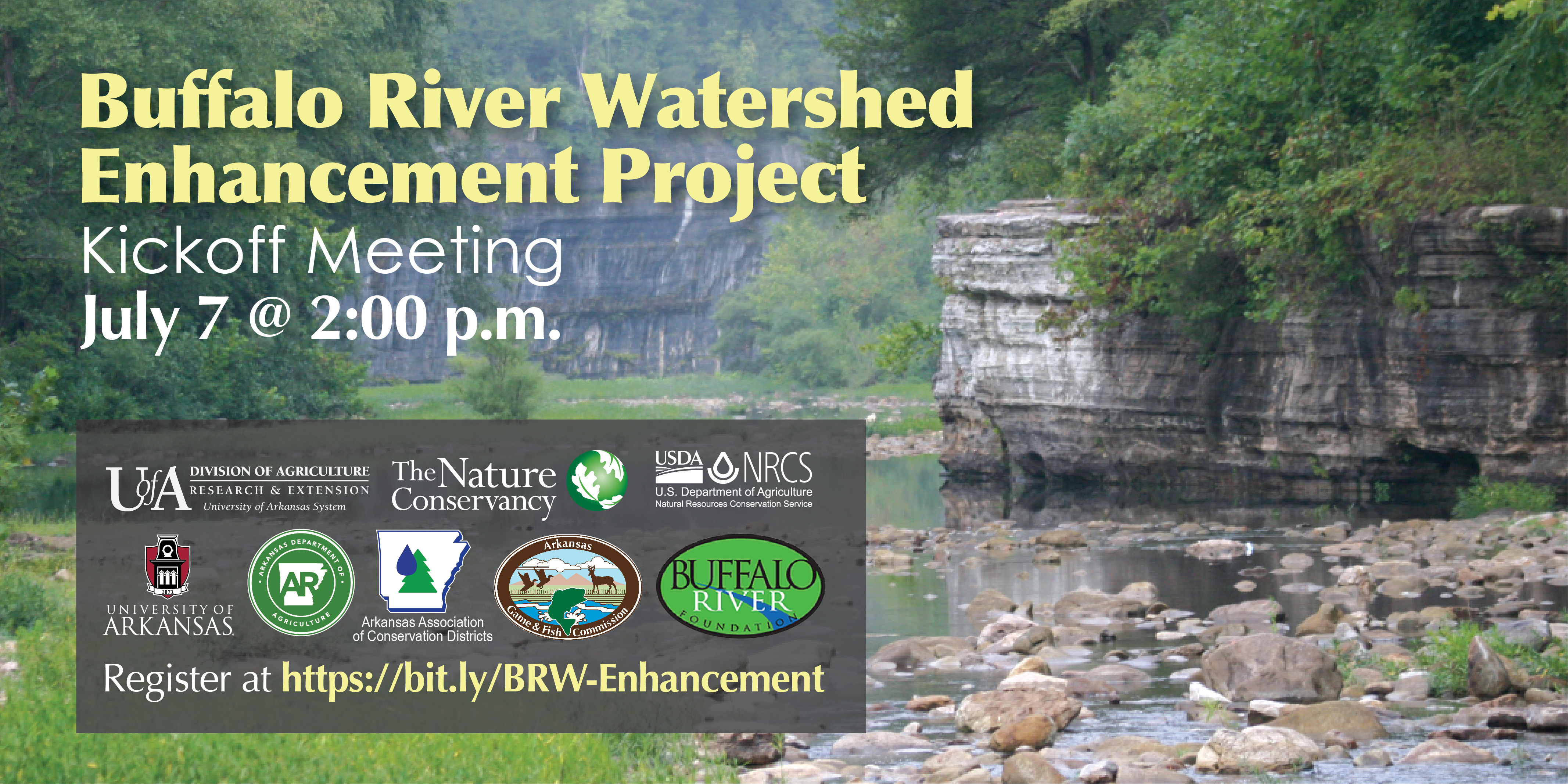July 2, 2021
Buffalo River Enhancement Project to hold online kickoff meeting
By Ryan McGeeney
U of A System Division of Agriculture
Fast Facts:
- Meeting scheduled for 2 p.m. on Wednesday, July 7
- Participation is free
(708 words)
LITTLE ROCK — Landowners in the Buffalo River Watershed are invited to join an online kickoff meeting for the Buffalo River Enhancement Project, scheduled for 2 p.m. on Wednesday, July 7.
John Pennington, extension water quality educator for the University of Arkansas System Division of Agriculture, said the meeting is intended to help interested stakeholders get up to speed on the project’s objectives.
“This meeting is to introduce the project, project partners, rationale, goals, and resources for landowners in the watershed,” Pennington said.
As part of the enhancement project, landowners and agricultural producers in the Buffalo River Watershed are eligible to receive conservation assistance funding to implement conservation practices to help maintain and improve water quality. Additionally, watershed landowners are eligible for assistance from the project partners aimed at eradicating feral hog populations, preventing erosion and managing pastures and unpaved roads in the area.
Clay Word, river conservation manager with the Nature Conservancy, a partner in the project, described the projects long-term goals.
“Broadly, the program will provide management solutions and alternatives for pasture
management, stream management, and unpaved road management,” Word said. “These management
practices will strive to reduce landowner financial costs and improve overall farm
productivity while also improving water quality throughout the watershed.”
The project is funded through the Natural Resources Conservation Service Regional
Conservation Partnership Program and includes partners from The Arkansas Department
of Agriculture Forestry Division and Natural Resource Division, Arkansas Game and
Fish Commission, University of Arkansas Cooperative Extension Service, the Center
for Training Transportation Professionals, the Buffalo River Foundation, the Buffalo
Conservation District, The Nature Conservancy and the Searcy County Agricultural Conservation
Cooperative.
“Through this large partnership the program is able to provide a wide variety of resources to meet a diverse set of landowner needs,” Word said. “The webinar next week will introduce the program and our partners in more detail. We will discuss how to apply for funding and assistance and provide a platform for landowners to ask any questions they might have.
“We can’t wait to get this project rolling and begin working with the folks who call the watershed home,” he said.
The webinar is free to join.
Pennington said there will be multiple sign-up opportunities for this special assistance over the next five years with up to $400,000 additional conservation funding available to share among qualifying landowners annually.
“The importance is that not only can these forms of conservation assistance help protect water quality in the watershed, but they can also improve farm profitability and habitat for native wildlife,” Pennington said. “Also of importance, this opportunity does not come around every day, or even very often.”
The Cooperative Extensions Service, part of the Division of Agriculture, is helping to provide site visits, outreach and information within the project area.
While the funding is potentially available throughout the Buffalo River Watershed, priority areas are Calf Creek, Bear Creek, Lower Big Creek, Tomahawk Creek and Brush Creek sub-watersheds in portions of Baxter, Marion, Pope, Searcy, Stone and Van Buren counties.
The funded conservation practices are intended to increase farm efficiency and reduce nutrients, sediment, and bacteria from moving off the landscape and into tributaries, and align with the recommendations from the Buffalo River Watershed Management Plan. Some examples of supported conservation practices include brush management, prescribed burning and pasture fencing.
Feral hog eradication
To receive assistance with feral hog eradication, landowners should call the USDA
Animal and Plant Health Inspection Service (APHIS) Arkansas Wildlife Services at (501)
835-2318. Wildlife Service technicians use state-of-the-art technology, including
remotely triggered enclosure gates, to trap and remove feral hogs from residents’
property.
Other agencies and organizations on the Arkansas Feral Hog Eradication Task Force are available to help. Residents who prefer to learn how to trap hogs themselves using new technologies, and are willing to host a field demonstration, or would like to pick up an Arkansas Feral Hog Handbook, contact your local county extension office (Uaex.uada.edu).
Other steps to help in the eradication of feral hogs and improvement of water quality are to report sightings and kills of feral hogs using the Feral Hog Reporting Survey 123 app from the Arkansas Feral Hog Eradication Task Force, available at https://www.agriculture.arkansas.gov/arkansas-department-of-agriculture-services/feral-hog/. Learn more about methods for effective control at https://www.uaex.uada.edu/environment-nature/wildlife/feral-hogs.aspx.
To learn more about The Buffalo River Watershed Enhancement project and other extension programs in Arkansas, contact your local Cooperative Extension Service agent or visit uaex.uada.edu. Follow us on Twitter at @AR_Extension.
About the Division of Agriculture
The University of Arkansas System Division of Agriculture’s mission is to strengthen agriculture, communities, and families by connecting trusted research to the adoption of best practices. Through the Agricultural Experiment Station and the Cooperative Extension Service, the Division of Agriculture conducts research and extension work within the nation’s historic land grant education system.
The Division of Agriculture is one of 20 entities within the University of Arkansas System. It has offices in all 75 counties in Arkansas and faculty on five system campuses.
Pursuant to 7 CFR § 15.3, the University of Arkansas System Division of Agriculture offers all its Extension and Research programs and services (including employment) without regard to race, color, sex, national origin, religion, age, disability, marital or veteran status, genetic information, sexual preference, pregnancy or any other legally protected status, and is an equal opportunity institution.
# # #
Media contact:
Ryan McGeeney
Communications Services
University of Arkansas System Division of Agriculture
Cooperative Extension Service
(501) 671-2120
rmcgeeney@uada.edu
